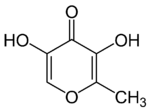5-Hydroxymaltol
 | |
| Names | |
|---|---|
| IUPAC name
3,5-dihydroxy-2-methylpyran-4-one | |
| Other names
3,5-Dihydroxy-2-methyl-4H-pyran-4-one | |
| Identifiers | |
| 3D model (JSmol) |
|
| ChemSpider | |
| PubChem CID |
|
| |
| |
| Properties | |
| C6H6O4 | |
| Molar mass | 142.11 g·mol−1 |
| Except where otherwise noted, data are given for materials in their standard state (at 25 °C [77 °F], 100 kPa). | |
| | |
| Infobox references | |
5-Hydroxymaltol, a derivative of maltol, is a substance that can be found in Penicillium echinulatum.[1] It is also found in toasted oak.[2] and also in honeys from blue gum (Eucalyptus leucoxylon) and yellow box (Eucalyptus melliodora).[3]
References
- ↑ 5-Hydroxymaltol and mycophenolic acid, secondary metabolites from Penicillium echinulatum. H.A. Anderson, J.M. Bracewell, A.R. Fraser, D. Jones, G.W. Robertson and J.D. Russell, Transactions of the British Mycological Society, Volume 91, Issue 4, December 1988, pp. 649-651, doi:10.1016/S0007-1536(88)80040-8
- ↑ Identification of volatile compounds with a “toasty” aroma in heated oak used in barrelmaking. Cutzach I, Chatonnet P, Henry R and Dubourdieu D, 1997, J. Agric. Food Chem. Vol 45, pp. 2217-2224 doi:10.1021/jf960947d
- ↑ Composition of Australian honey extractives. 1. Norisoprenoids, monoterpenes, and other natural volatiles from blue gum (Eucalyptus leucoxylon) and yellow box (Eucalyptus melliodora) honeys. D'Arcy, B.R., Rintoul, G.B., Rowland, C.Y. and Blackman, A.J. J. Agri. Food Chem. vol 45, 1997, pp. 1834-1843, doi:10.1021/jf960625+
This article is issued from
Wikipedia.
The text is licensed under Creative Commons - Attribution - Sharealike.
Additional terms may apply for the media files.